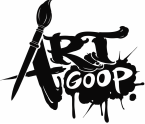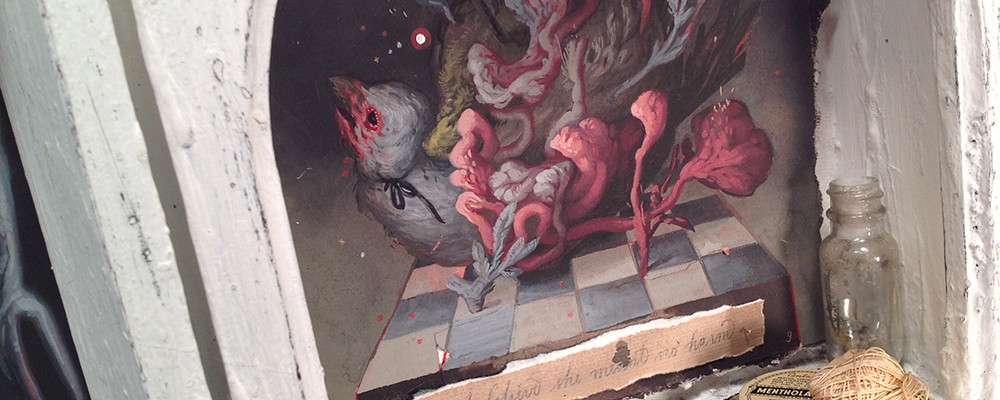|
1. Who were your teachers or influences?
I can separate my influences into two very rough (and partially overlapping) categories: hand and mind. For the former, I can say, a huge influence on my draftsmanship as a young teenager was Mucha: I, like a lot of folks, was absolutely gobsmacked with his line quality, not only in his finished commercial work, but also in his illustrative work and sketches. I never even particularly liked drawing ladies, but I spent hours trying to master his effortlessness around bottom lips and nose points and slitted bedroom eyes. Trying to master him started me on the path to learning just how much work and repetition it takes to move draftsmanship forward. As for the mind, I’ve been really excited about mid-century movements in the past few years, and their approach to the concept of what makes an artwork. Fluxus, Actionism, conceptual art, and whatnot. I’ve got a lot of work ahead of me to process what it means for my own work, which is rather obviously still mired in old-fashioned notions of the artwork and hand-work. But I’m trying to stretch my oeuvre, at least, with more assemblage and film pieces, when the opportunity presents itself. I recently did a large installation in conjunction with my solo show at Thinkspace entitled “I’ve Made My Bed, Now’, which was a great opportunity to do an installation in a public setting. 2. What techniques or tricks did you find most useful when learning to paint? Gouache is one hell of a teacher. It taught me that I’m not the boss. It’s so finicky and particular about the way that it wants to be handled, and I learned that I would have to be the flexible material, not it, if I wanted to master it. I learned to embrace more spontaneity and experimentation, less rigidity in my technique, to see a mistake as a part of process to be included and cherished in a painting. For instance, you can’t have rigid expectations of palette with gouache, because it dries different colors than when it’s wet, and different still from when it’s straight out of the tube. I learned to enjoy whatever accidental artifacts bloomed up whilst layering. I learned that “painting well” is rather an arbitrary notion, and that “screwing up” can easily be reframed as “painterliness.” 3. What are 3 key principles of making good art, in your opinion? I don’t particularly like the classification of “good art”, since the terms of judgment are arbitrary at best (and fascist at worst), and “bad art” can be just as useful and instructive as “good art”, if we’re naming one or the other. For me, I think best practices can be boiled down to 1. Make art, 2. As much as you can, 3. From the gut. (Wherein “the gut” is both a full, digesting belly of inspiration and thinking, and the inner, automatic impulses of your own mind.) 4. What are the most common mistakes that you see other artists make? Hey, anyone’s entitled to the work that they make, I suppose I’m no better judge than anyone else. For me, personally, I like to see art where the process of, and joy taken in, the making of a piece is apparent. I think the meat of a painting (, drawing, sculpture, thought bubble) is the human-time and human-hand and human-mind encoded therein, not just the final product, and I like to see how much fun the artist had in making it. I think you see a lot of work that looks churned-out and coldly composed, and it’s absolutely boring to me. Think and play your work. Squelch and touch and poke your work. Mess it, ruin it, violence it. It’s not a quiet, sacred ossification of image— it’s a place of mind-play, expression, material-squeezing, mark-making. 5. Can you break your painting process down into 10 steps, or less, for us? 1. Idea/concepting stage: I work constantly, obsessively, in a sketchbook, hours every day. If I need to make a few paintings, I'll pore over the last month or two of work and pull out ideas. Sometimes, if I'm making a series or a show, I'll keep a side thumbnail page of possible paintings. 2. Narrowing: once I have an idea of what I'd like to use for a piece, I'll try to spend some time exploring it in sketches, considering different angles, inclusions, overlays, compositions. If there are a lot of moving parts in the piece, or if the composition could have a few different outcomes, I might make copier paper cutouts of the parts and move them around until I'm happy, and re-draw that. 3. Transferring to painting surface: it varies how closely I follow the sketches. Sometimes I'll take the general idea of what I've been working on in the sketchbook, and re-draw it on the larger paper. Sometimes, if I've spent a lot of time really hammering into the composition, especially for larger paintings, I'll transfer it with an old overhead projector I have. I'll either use a hard graphite pencil or a light red pencil for this bit. I'll have prepped the surface with at least one wash of color before drawing, just to have something down. 4. Starting painting: Typically, I'll get a wash or two of the background in so that I have have a mental base for the other values in the painting. Afterwards, I'll lay in the general values of the painting subjects, just roughly set where the darks are (and the lights, by omission). 5. The boring meat: After laying in values, I'll fill in with opaque layers, bit by bit, in no particular order than my whim at the time (or, sometimes, in a manner that helps balance tones from one side to the other). I usually blend on the piece, so I spend a lot of time moving between sections, blending them into each other. 6. The fun meat: In between layers, or when I feel like it, I write, draw, and collage in the piece. Sometimes I keep track of hours in the piece, sometimes they're shopping or to-do lists, sometimes it's things I've heard on the radio. 7. Loosening: Once larger areas of the piece are complete and blended, it tends to look a little tight, so I'll go through and mess it up with texture brushstrokes. Hatching and whatnot to undo some of the rendering.
1 Comment
|
Art GoopArt Goop is a Q&A for artists by artists. We ask questions designed to examine the techniques and methods of some of the most inspiring artists working today. Categories
All
Archives
September 2017
|


 RSS Feed
RSS Feed